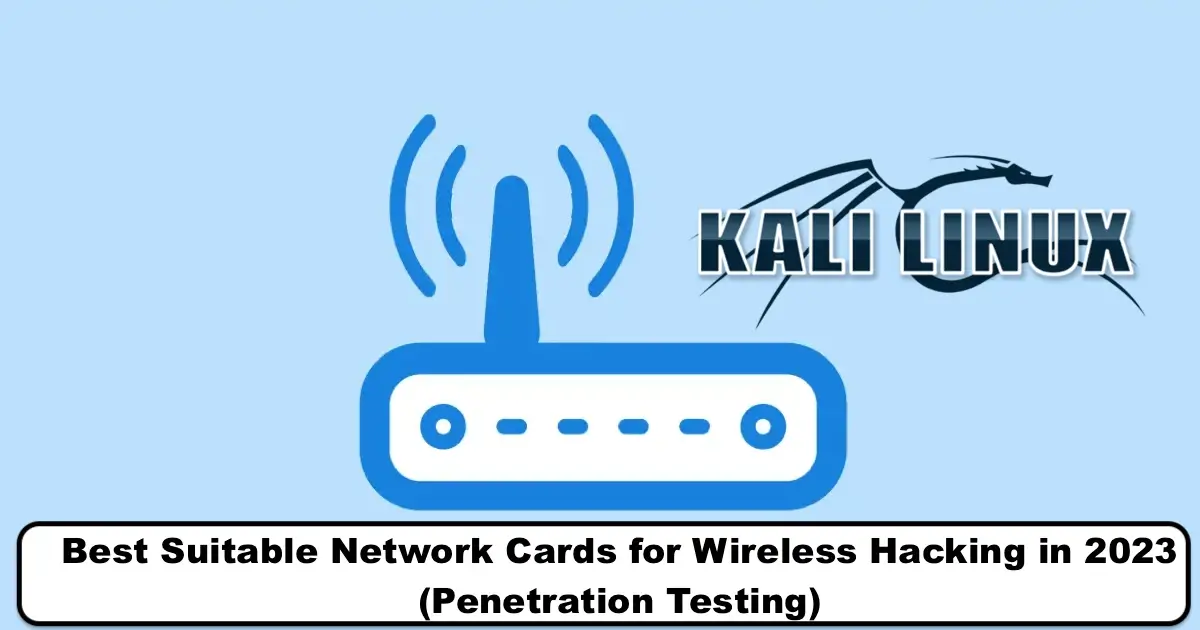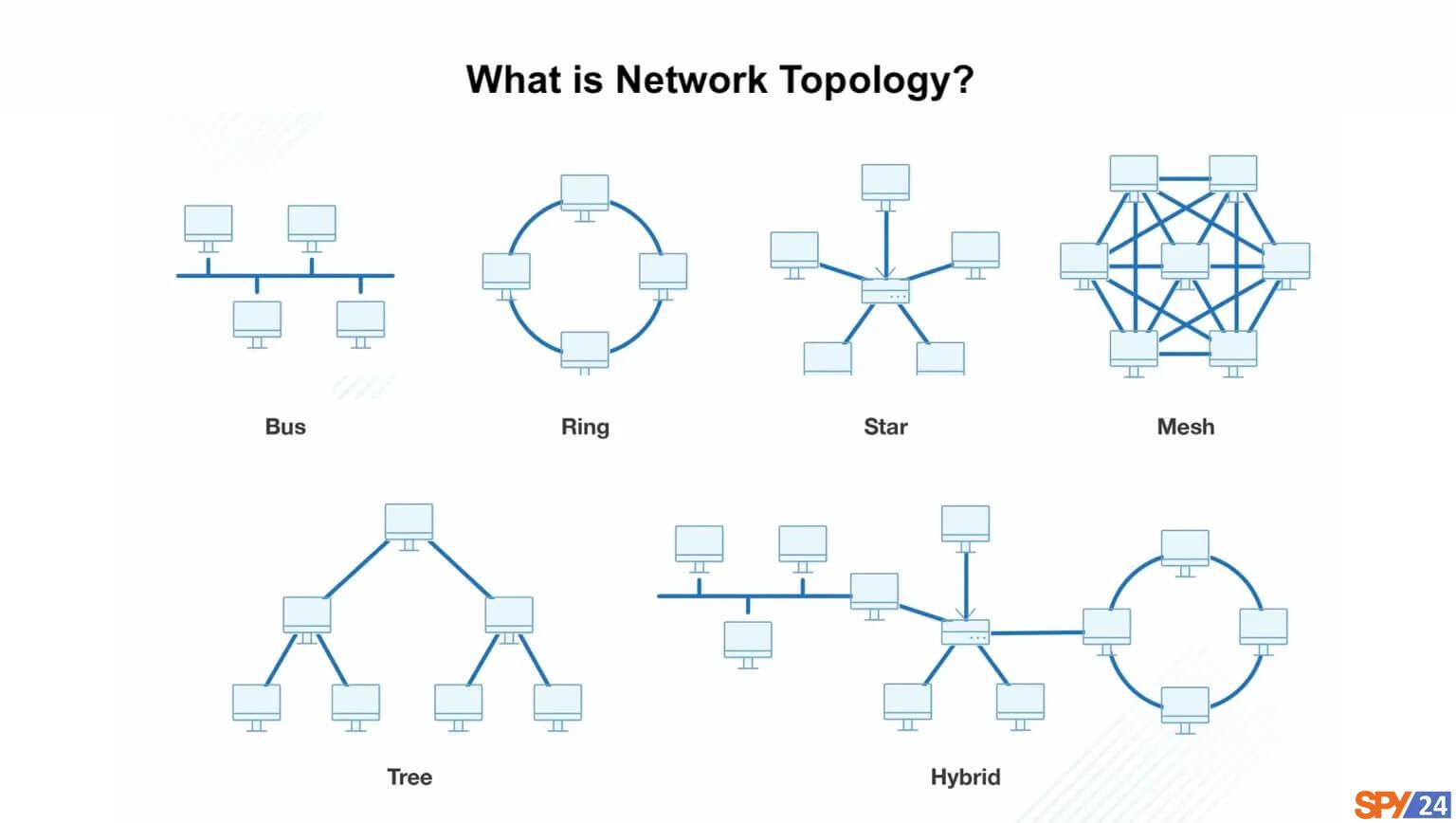
Definition of Network Topologies, Types of Network Topologies: We are now in the age of communication, and information is our valuable asset. Sharing it with others to meet our work and personal needs is part of our daily plan. To facilitate communications and information exchange, computer networks were created. A computer network includes a number of computers and hardware, like switches, hubs, etc., that are connected through communication channels. They share their hardware and software resources. The layout and the way network systems are connected vary and are referred to as network topology. Stay with us as we discuss the types of network topologies further. You can also read the article “How to Find Mac Address Windows 11?“
What is Network Topology?
Topology or connectivity refers to the connection and layout of a network’s equipment. To set up a computer network, first, you need to specify the network topology.
There are two types of topology: physical topology and logical topology. The physical topology determines the layout of network elements and how they communicate with each other. The logical topology determines how information and data are transferred between network elements.
There are two common terms in computer networks that you should learn first: a link or link between two groups of systems in a network is called a link, and each element of the network is called a node.

There are generally five types of physical network topology: linear, circular, star, mesh, and hybrid.
Types of Computer Network Topologies
Next, we will discuss network topology types further:
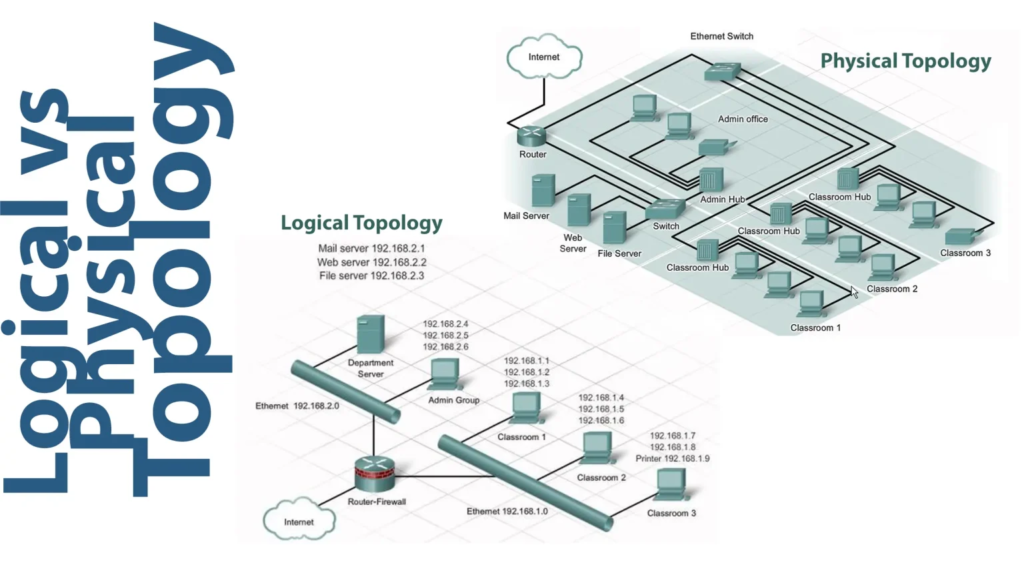
Physical topology
Physical topology determines the layout of network elements and how they communicate with each other. There are a total of seven types of physical topology.
- Bus Topology
- Star Topology
- Ring Topology
- Mesh Topology
- Tree Topology
- Point To Point Topology
- Hybrid Topology
Logical topology
Logical topology determines how information and data are transferred between network elements. There are two types of logical topology.
- Ring Topology
- Bus Topology
What is Bus Topology?
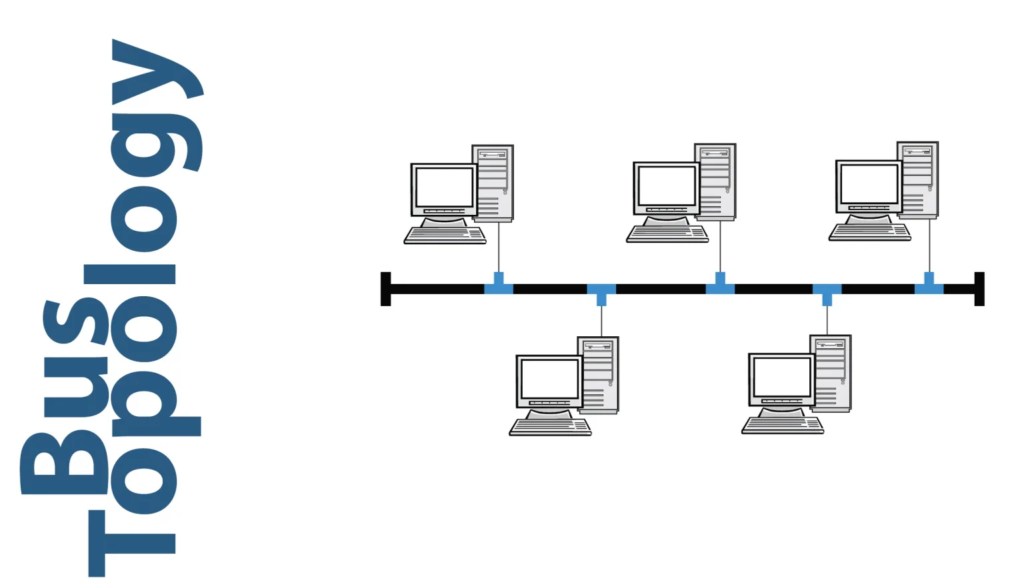
In Bus topology, information is transferred in one direction at any given moment. Each network node is connected to one cable.
Advantages and Disadvantages of Bus Topology
Advantages of Bus topology:
- It uses less cable compared to other topologies.
- It is easily used in small networks.
- Its implementation, setup, and troubleshooting are easy.
- It is more cost-effective compared to other topologies.
Disadvantages of Bus topology:
- If a single cable is faulty or disconnected, the whole network is out of the circuit.
- If one computer in the network uses heavy software or occupies a large part of the network bandwidth, it negatively affects the speed and performance of other network member systems.
- Cables have a length limit and cannot be used to establish communication between systems at a distant distance.
- Bus topology has a slower data transfer rate compared to a ring topology.
Star Topology
Another of the physical network topologies is the star topology, which has the following advantages:
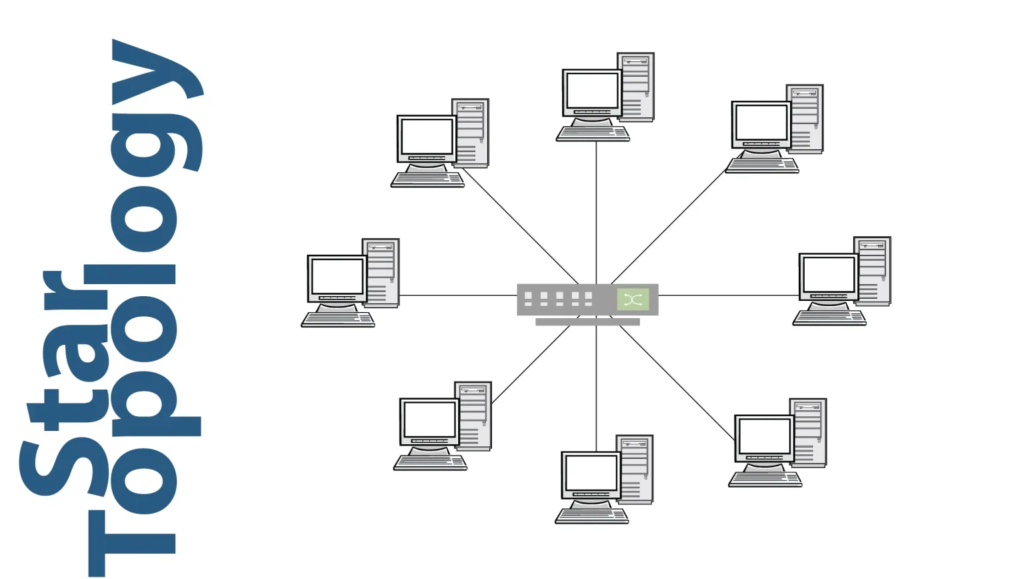
Advantages and Disadvantages of Star Topology
- Each device has an independent connection to the hub. If necessary, the network hub can be easily upgraded.
- This topology can use both optical fiber cables and Coaxial cables.
- The hub at the center of the topology acts like a REPEATER.
- Implementation, setting up, and troubleshooting this type of network is easy.
- If any of the network nodes encounter a problem, it does not disrupt the network’s workflow. Only that defective node is removed from the circuit.
Disadvantages of Star Topology
The cost of installing and setting up this topology is high.
If the hub fails, the entire network goes out of the circuit.
The network’s speed and performance depend on the hub’s capacity.
Ring Topology
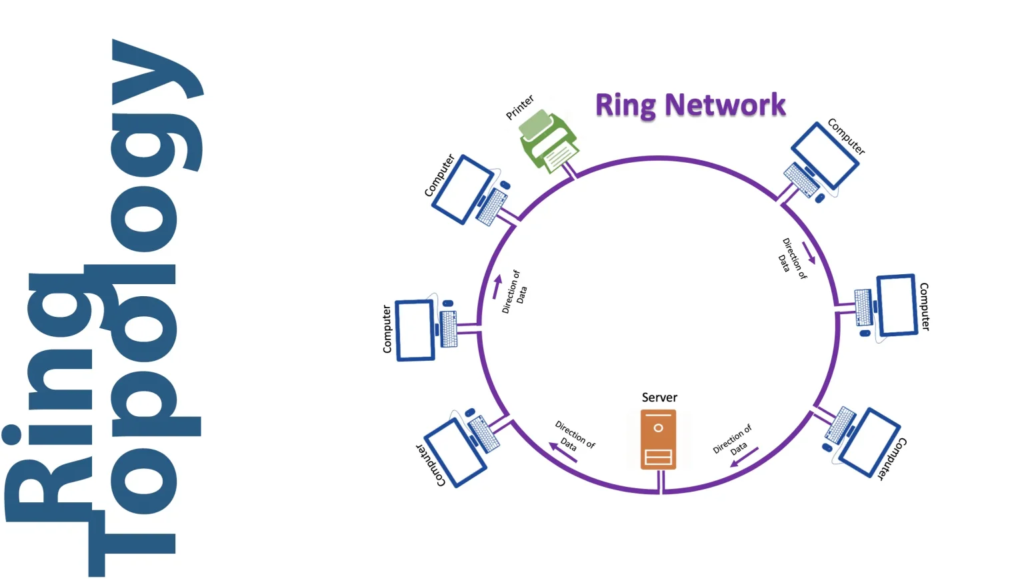
All network member systems are connected in a circular way to each other, and data starts circulating in the direction of the clock hands to reach its destination. This technology is commonly known as Token Ring. The first computer to be turned on creates a signal as a Token, and this token starts moving around the network. Whenever a computer wants to send data, it waits for this token to reach it, and then it sends the data.
In reality, this token allows each system to send while it circulates. When the sent data arrives at its destination, the destination system sends a message under the name Acknowledge to inform the originating system that it has received the data.
Troubleshooting ring topology is difficult, and due to the structure of this topology and the need for a token to transfer information, its speed is slow. Also, a problem in one node causes problems in the entire network.
Mesh Topology
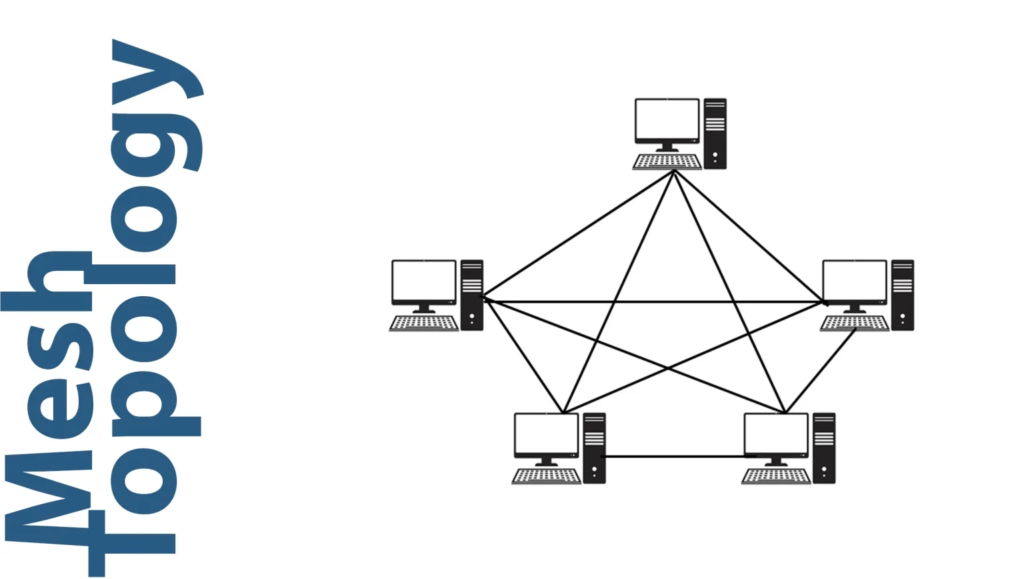
In this topology, all network nodes are interconnected.
In this type of topology, devices connect to each other point-to-point, and all network nodes are interconnected. For data transfer on mesh topology, two methods of routing and flooding are used. In the routing method, data determines the shortest distance between the source and destination based on network routing logic and uses it for information transfer, but in the flooding method, similar data is sent to all member systems of the network.
Other features of this topology include the following:
- It is more powerful than other topologies.
- This topology is not flexible at all.
- Network errors in this type of topology are easily identifiable and rectifiable.
- In this topology, all network devices are connected to each other.
- The level of security and privacy preservation in this topology is high.
- Data load only affects the cable and communication channel between the source and destination devices.
What is Tree Topology?
This topology has a central device, and all network devices are connected to the central device in a specific order. Tree topology is used in large networks and includes more devices compared to linear and star topologies.

Advantages and Disadvantages of Tree Topology
- All network member devices are easily manageable and supportable.
- Expansion and troubleshooting in this network is easy.
Disadvantages of Tree Topology include:
- Compared to other topologies, its setup costs more.
- If the central device has a problem, the entire network goes out of the circuit.
- A lot of cables are used to set up this topology.
Point To Point Topology (P2P)
The point-to-point topology is also referred to as P2P.
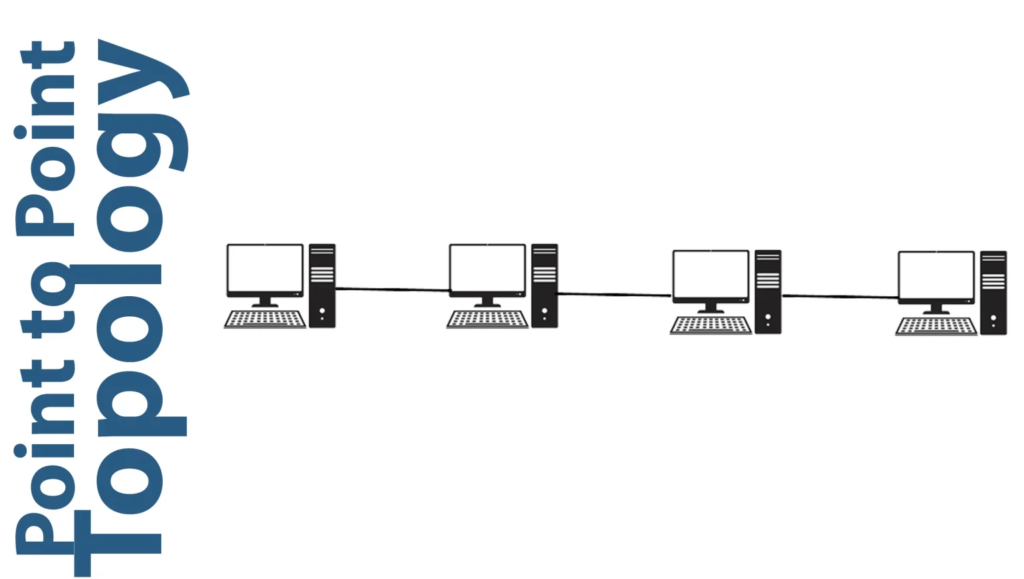
In a point-to-point topology, devices are interconnected using a cable, like connecting two computers, two switches, or two routers to each other. The point-to-point topology in network texts is written in two ways, P2P and Peer To Peer. In this topology, between the receiver and sender, there are other intermediary devices for shaping the connection, but in appearance, only the sender and receiver seem to be there, like in radio communications.
Hybrid Topology
Hybrid topology comes from merging two or more different network topologies with each other. For example, merging a star topology with a linear topology creates a hybrid topology.
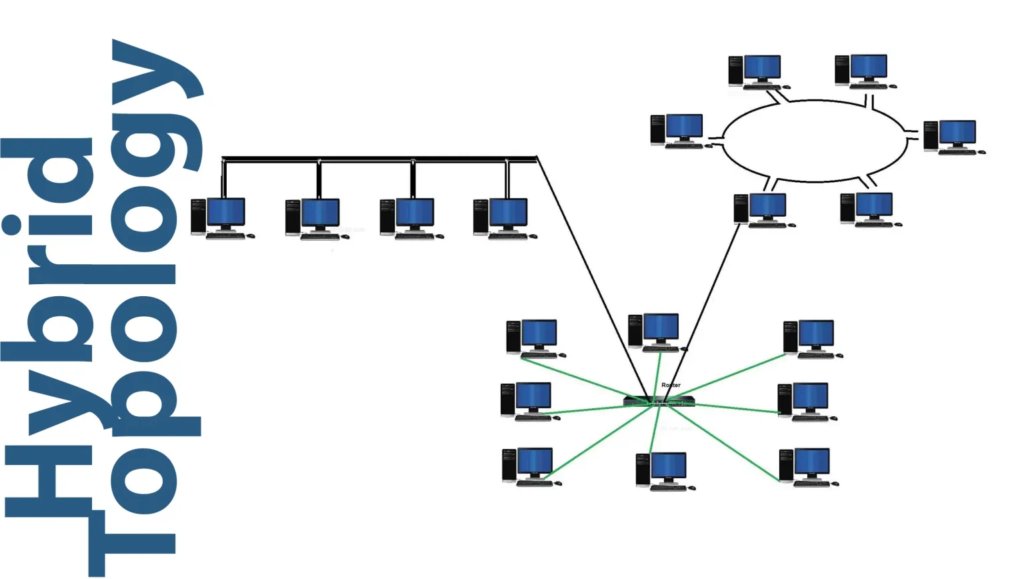
Advantages and Disadvantages of Hybrid Topology
- This topology is flexible and more reliable.
- It encompasses a larger number of devices.
- If a part of the network is defective, the entire network will not be disconnected.
- The possibility of connecting other topologies is easily available.
- Debugging or isolating a specific topology from the entire network is easy.
The disadvantages of the hybrid network topology include the following:
- The hybrid network topology is the most expensive network topology.
- Managing and maintaining this network is more difficult.
- It also has a high cabling cost.
What is Internet Topology?
One of the very widespread and global networks is the Internet, which allows you to quickly send your information without time and space limitations. For example, you can attach your photos to your email and send them to your sister in America. Connection to the Internet is possible through all smart systems equipped with a network card. Network protocols include Http, Https, and Ftp.
What is an Ethernet Network?
Ethernet technology is the most common method of computer communication in LAN networks. It connects devices within a network and allows information exchange between them using a common language. LAN networks are suitable for small offices, homes, or a building. Communication in this type of network is Ethernet, and the transmission of information and formatting of data in a way that other network nodes can detect, receive, and process is performed. There are two types of Ethernet networks, which we will examine further.
Fast Ethernet
The data transfer speed is 100 megabits per second. It uses fiber optic or twisted-pair cables.
Gigabit Ethernet
The data transfer speed is 1000 megabits per second. It uses fiber optic or twisted-pair cables.
What is a CAN network?
CAN network stands for Campus Area Network. It comes from a combination of several LANs that are interconnected via switches and routers. These networks are used in educational centers, the military, companies, and some organizations. Using CAN, you can cover the local networks of several neighboring buildings. CAN network nodes be interconnected using fiber optic and 10 gigabit Ethernet?
CAN network management be performed from a single point? The network manager reviews the communications and transactions and, if necessary, issues more access permissions or restricts access. CAN network security is provided by a firewall. The data transfer speed in these networks is high due to the local origin and destination, and it is easy to share large files.
Frequently Asked Questions
What is network topology? And what are its types?
Connectivity or topology (Topology) refers to the way equipment in a network is connected and arranged. When setting up a computer network, the network topology must first be determined. There are two types of topology: physical topology and logical topology.
Advantages and disadvantages of hybrid topology
Advantages:
1- This topology is more flexible and reliable.
2- It can include a greater number of devices.
3- If a part of the network is faulty, the entire network will not be out of the circuit.
4- It is easy to connect to other topologies.
5- Troubleshooting or isolating a specific topology from the entire network is an easy task.
Disadvantages:
1- Hybrid topology is the most expensive network topology.
2- Managing and maintaining this network is harder.
3- It also has a high cabling cost.




